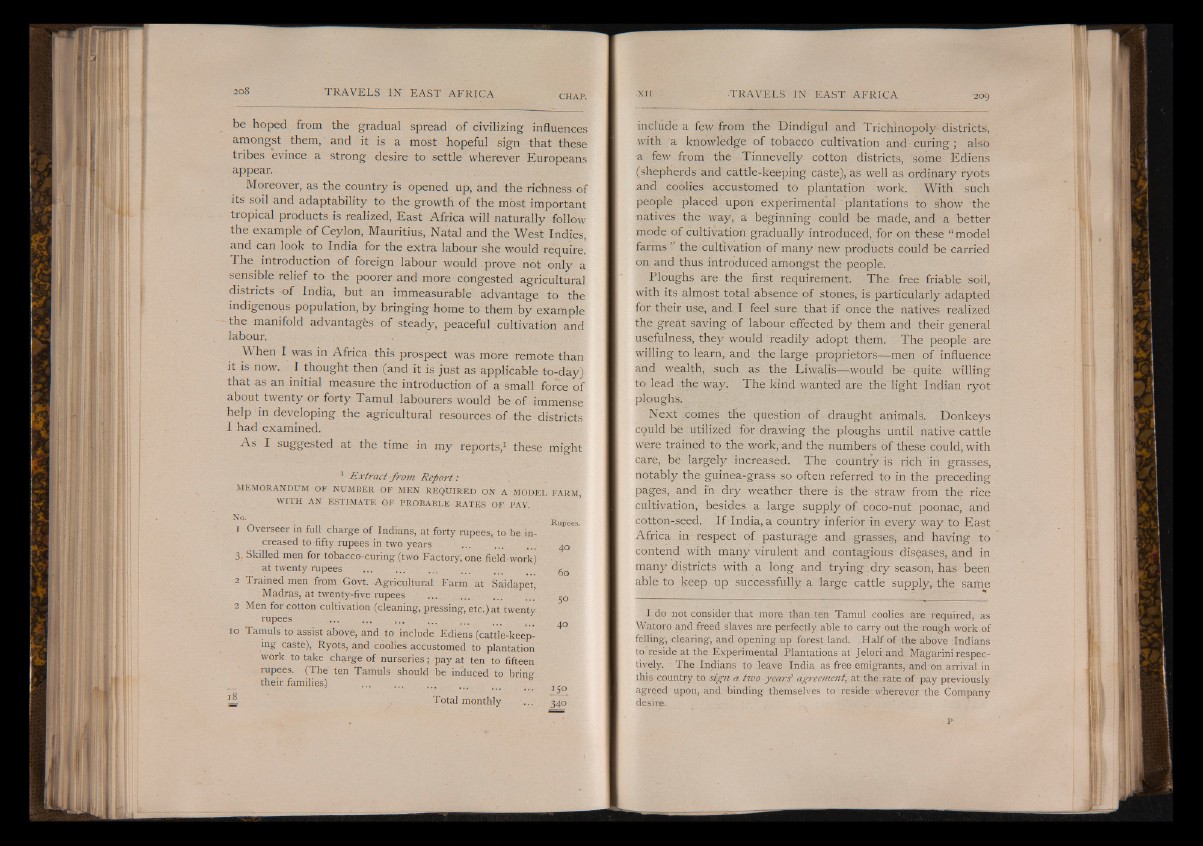
be hoped from the gradual spread of civilizing influences
amongst them, and it is a most hopeful sign that these
tribes evince a strong desire to settle wherever Europeans
appear.
Moreover, as the country is opened up, and the richness of
its soil and adaptability to the.growth of the most important
tropical products is realized, East Africa will naturally follow
the example of Ceylon, Mauritius, Natal and the West Indies,
and can look to India for the extra labour she would require!
The introduction of foreign labour would prove not only a
sensible relief to the poorer and more congested agricultural
districts of India, but an immeasurable advantage to the
indigenous population, by bringing home to them by example
- the manifold advantages of steady, peaceful cultivation and
labour.
When I was in Africa this prospect was more remote than
it is now. I thought then (and it is just as applicable to-day)
that as an initial measure the introduction of a small force of
about twenty or forty Tamul labourers would be of immense
help in developing the agricultural resources of the districts
I had examined.
As I suggested at the time in my reports,1 these might
1 Extract from Report :
MEMORANDUM OF NUMBER OF MEN REQUIRED ON A MODEL FARM,
WITH AN ESTIMATE OF PROBABLE RATES OF PAY.
No. - ' .
r \ r 11 -i - . - . Rupees.
1 Overseer in full charge of Indians, at forty rupees, to be increased
to fifty rupees in two years .......................... 4o
3, Skilled men for tobacco-curing (two Factory, one field-work)
at twenty rupees ........... ............... ...............
2 Trained men from Govt. Agricultural Farm at Saidapet,
Madras, at twenty-five rupees ... ...
2 Men for cotton cultivation (cleaning, pressing, etc.) at twenty
ruPees ..................... ... 40
io Tamuls to assist above, and to include Ediens (cattle-keeping
caste), Ryots, and coolies accustomed to plantation
work to take charge of nurseries; pay at ten to fifteen
rupees. (The ten Tamuls should be induced to bring
their families) ... ... ... ... JgQ
_ ^ Total monthly ... 340
include a few from the Dindigul and Trichinopoly districts,
with a knowledge of tobacco cultivation and curing ; also
•a few from the Tinnevelly cotton districts, some Ediens
(shepherds and cattle-keeping caste), as well as ordinary ryots
and coolies accustomed to plantation work. With such
people placed upon experimental plantations to show the
-natives the way, a beginning could be made, and a better
mode of cultivation gradually introduced, for on these “model
farms” the cultivation of many new products could be carried
on, and thus introduced amongst the people.
Ploughs are the first requirement. The free friable soil,
with its almost total absence of stones, is particularly adapted
for their use, and I feel sure that if once the natives realized
the great saving of labour effected by them and their general
usefulness, they would readily adopt them. The people are
willing to learn, and the large proprietors— men of influence
and wealth, such as the Liwalis—-would be quite willing
to lead the way. The kind wanted are the light Indian ryot
ploughs. ,
Next-comes the question of draught animals. Donkeys
cquld be utilized for drawing the ploughs until native cattle
were trained to the work, and the numbers of these could, with
care, be largely increased. The country is rich in grasses,
notably the guinea-grass so often referred to in the preceding
pages, and in dry weather there is the straw from the rice
cultivation, besides a large supply of coco-nut poonac, and
cotton-seed. I f India, a country inferior in every way to East
Africa in respect of pasturage and grasses, and having to
contend with many virulent and contagious diseases, and in
many districts with a long and trying dry season, has been
able to keep up successfully a large cattle supply, the same
I do not consider that more than .ten Tamul coolies are required, as
Watoro and freed slaves are perfectly able to carry out the rough work of
felling, clearing, and opening up forest land. Half of the above Indians
to reside at the Experimental Plantations at Jelori.and Magarini respectively.
The. Indians to leave India as free emigrants, and on arrival in
.this country to sign a two year? agreement, at, the. rate o f pay previously
agreed upon, and binding themselves to reside wherever the Company
desire.